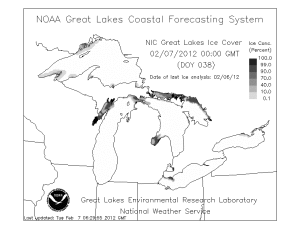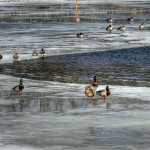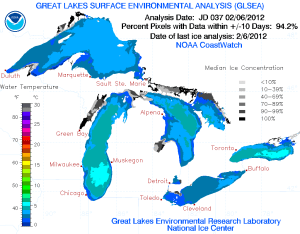We have much more to do and your continued support is needed now more than ever.
Danger: Thin Great Lakes Ice
Great Lakes Ice Cover
All of us in the Great Lakes region (and perhaps other regions also) are either enjoying or fretting over what is such a mild winter. Air temperatures remain above average and snowfall amounts are very small. In fact, in Michigan we’ve had more rain than snow this winter. But, what effect has this mild winter had on Great Lakes ice? Let the images speak for themselves.

Here is the average ice cover over the entire Great Lakes in February from the years 1973 to 2002. Red, orange and yellow areas indicate thick ice. Pay special attention to Lake Erie.

NOW look at Lake Erie. In this image the darker areas indicate the thickest ice. Lake Erie is very light.
Stunning, isn’t it.
Lake Erie as the Canary
Why is the lack of Lake Erie ice important? Lake Erie is the shallowest Great Lake with the least volume of water. That is why it is usually the first lake to develop and retain ice throughout the winter.
Lake Erie does most of its freezing in February so if temperatures continue on this warm path, it may not freeze at all this winter.
Consequences of Thin Ice
We hear a lot about how thin ice in the Arctic harms polar bears and other Arctic wildlife and people, but how does thinning lake ice affect Great Lakes wildlife and people?


Lack of ice cover may also cause problems for fish populations. Many fish species depend on the protection that ice cover provides their eggs from dangerous winds or waves. Also, ice cover helps to ward off any bacterial growth that may affect the survival of the fish. Ice fishing – part of a multi-billion dollar fishing industry is also affected as the ice is a no longer reliable platform to partake in the activity.
Nearshore wetlands and shorelines, habitat for many wildlife species, are also affected as they depend on stable ice for protection from erosion. Our wetlands in the Great Lakes are vital to bird and other amphibian habitat, protecting the lakes from sediment pollution and cleaning our drinking water. We need them to stay on the shore.
Ice cover also provides protection from wintertime evaporation of the lakes. Evaporation rates are the highest in the winter. Sustained lack of ice cover over a few years or decades could contribute to lower lake levels.
When it comes to another very large economic driver in the Great Lakes, shipping, timing is everything. If the temperatures cool and the lakes freeze later into the spring it can cause issues for the industry. Heavy ice conditions in early spring can delay the shipping season and cause navigational problems.
What’s in store for Lake Erie’s ice?
The National Oceanic and Atmospheric Administration’s (NOAA) Great Lakes Environmental Research Laboratory is creating ice forecasting models as part of their Great Lakes Coastal Forecasting System. Currently they are able to forecast circulation, temperature, and wave conditions the lakes. Ice cover and thickness will give us even more information to prepare for conditions as they come. Here is the forecast for the next ten days. Dark colors indicate ice concentration and brighter colors indicate the water temperatures.

As for the longer-term, we need to work together to reduce temperature-raising greenhouse gas emissions in order to protect wildlife and people. Brenda Archambo, long-term Michigander and ice fisher (her family’s been ice fishing for four generations!) recently made the case to the EPA to cut carbon pollution from cars. Hear her story and watch her testimony here.





















